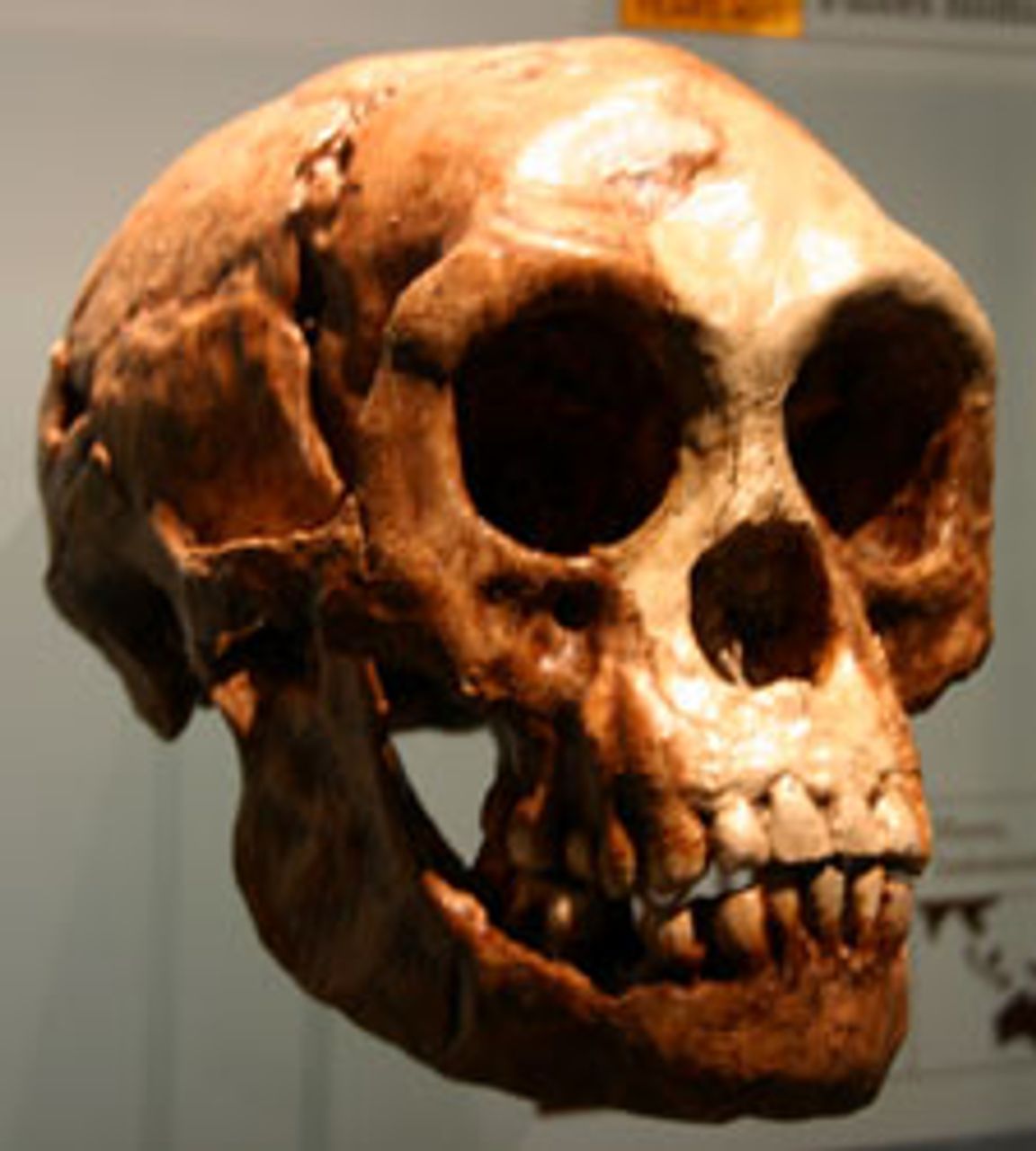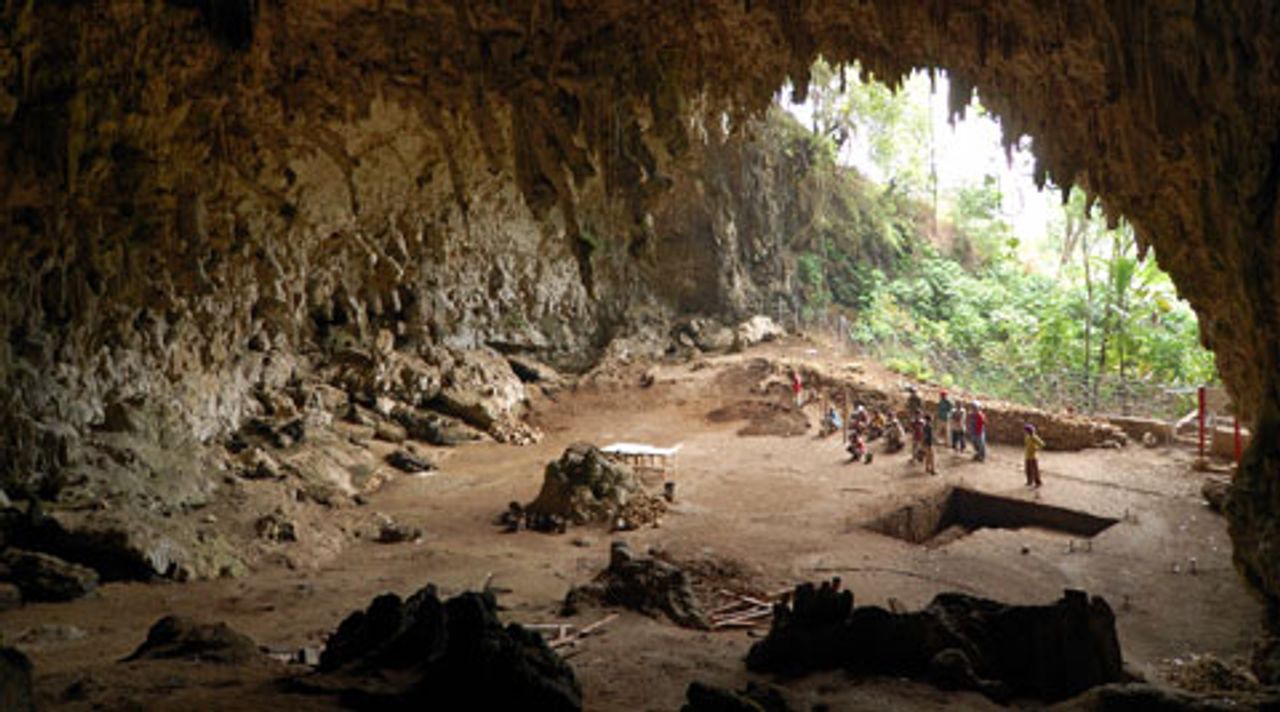 Homo floresiensis Credit: Ryan Somma
Homo floresiensis Credit: Ryan SommaA recent conference at the State University of New York at Stony Brook and several new publications contribute to the developing understanding of the proposed new hominin species Homo floresiensis, also known as the Flores hobbits (an allusion, due to their small size, to the child-sized characters from The Lord of the Rings). The results tend to support both the evolutionary distinctiveness of the so-called hobbits, and to provide new insights into human evolution in general.
The existence of this previously unknown human species was first announced in 2004 based on the recovery of skeletal remains on the Indonesian island of Flores (See “‘Hobbits’ of Flores: Implications for the pattern of human evolution” ).
 Cave where the remains of Homo floresiensis where discovered in 2003, Lian Bua, Flores, Indonesia Credit: Rosa Cabecinhas
Cave where the remains of Homo floresiensis where discovered in 2003, Lian Bua, Flores, Indonesia Credit: Rosa CabecinhasThis discovery has set off a substantial debate among paleoanthropologists (scientists who study human origins). The controversy involves differences of interpretation regarding the remains themselves. The discoverers claim that these specimens represent a distinct hominin species that continued in existence until as recently as about seventeen thousand years ago and coexisted, at various times, with other members of the genus Homo, including Homo erectus and Homo sapiens.
Opposing scholars disagree, arguing that these are in fact modern humans whose unusual characteristics are attributable to a variety of factors. The creature’s small size (about one meter, or a little more than three feet, tall) and unusual anatomical features are said to be the result of such factors as island dwarfism—the tendency of animals to become smaller when confined to small, isolated islands—and/or diseases such as microcephaly, a genetic disorder which results in abnormally small brains and mental retardation.
Much research has already been generated by this discovery and more was announced at the conference and in recent publications. The weight of evidence seems to be tending toward confirmation of the discoverers’ interpretation, but the issue has by no means been settled.
Differences of interpretation are normal in science, when new and unexpected discoveries occur. Struggle over how the new information fits, or doesn’t fit, within the existing framework of understanding in a given field of study is the dialectical process by which knowledge develops.
In the case of the hobbit discovery, the emerging controversy suggests that important components of our current understanding of human evolution are being brought into question. As has been discussed in previous articles published on the WSWS, there are two major models of the broad pattern of human evolution: the “Multiregional” and the “Out of Africa” hypotheses.
Proponents of the Multiregional hypothesis such as Erik Trinkaus and Milford Wolpoff have argued that early populations of the genus Homo, migrating from Africa into Eurasia before 1.8 million years ago, maintained some genetic contact with each other and with larger populations remaining within Africa. They have supported their arguments by pointing to degrees of morphological continuity within populations in Europe or Asia before and after putative replacement events, and maintain that the evolution of modern Homo sapiens occurred over a wide geographic area.
 Flores Island (yellow) and Indonesia
Flores Island (yellow) and IndonesiaThe Out of Africa hypothesis suggests that later migrations from Africa completely displaced Eurasian populations, which had been genetically isolated following their initial dispersal from Africa. This hypothesis originated from the observation that certain ancient human specimens in Eurasia, and in particular those attributed to H. neanderthalensis in Europe, possessed extraordinarily robust features which vanished in the fossil record as modern features emerged. This theory has become the dominant one in recent decades, as geneticists have hypothesized a recent African ancestor for all living humans using the nuclear and mitochondrial DNA of both modern humans and even fossil Neanderthals.
The discovery of H. floresiensis, if ultimately confirmed to represent a separate species of hominins, definitively pushes the argument toward the latter interpretation.
An important factor in validating a new discovery in science is not only whether it fills in its own missing piece within a larger theoretical framework, but if it helps clarify other aspects of that framework. New research results regarding the hobbits’ form of locomotion appear to do just that. In order to understand the implications of the hobbits’ way of getting around, it is necessary to briefly review what is known about the evolution of human locomotion and how that differs from the more normal pattern among apes.
Fossil apes are first known from the Miocene geologic period, 23-5 million years ago (mya) in Africa, Europe and Asia. At that time, apes lived in extensive tropical forests. During the succeeding Pliocene period, roughly 5-1.8 mya, the climate became cooler and dryer. As a result, the forests tended to become smaller and ‘patchier,’ interspersed with stretches of open grassland known as savannah.
Available evidence suggests that Miocene apes were adapted to the forest habitat and spent much time in trees, with such anatomical adaptations for climbing as a splayed big toe. When on the ground, modern apes and their ancestors walk on all four limbs, using a form of locomotion known as ‘knuckle walking,’ because they use the knuckles of their hands to contact the ground rather than their palms as do monkeys.
As the environment changed, some apes, such as the ancestors of gorillas and chimpanzees, retained their adaptation to the shrinking forests. Others evolved to survive in the more open habitat. It is thought that this latter group led to the evolutionary line classified as hominins, including the genera Australopithecus and Homo (i.e. humans).
Fossil evidence indicates that one of the earliest distinctive hominin biological adaptations, of those that can be discerned in skeletal remains, was habitual bipedalism: walking upright on two feet as the standard method of locomotion. Chimps, the closest human relatives, can walk upright for limited periods, but awkwardly and not quickly.
It is thought that bipedalism provided a number of evolutionary advantages for apes previously adapted to the relative safety and nutritional abundance of tropical forests. Both Darwin and Engels noted that among these benefits may have been the ability to carry objects, such as food and eventually tools, from one safe location to the next. Bipedalism may also have provided the ability to peer over the tall grass to spot potential predators on the savannah, where there were few trees offering protection against predators.
Recent research by Herman Pontzer and Daniel Lieberman, using a technique called experimental biomechanics, has found human bipedal locomotion to be vastly more efficient than any form of locomotion available to chimpanzees, including quadrupedal knucklewalking, climbing, and bipedalism. This research indicated that habitual bipedalism among hominins may have also been an adaptation to the increasingly arid and cool climate, by lowering hominin energy requirements while food abundance decreased.
Fossil evidence, including fossilized bone and two sets of fossilized footprints, seems to support the interpretation that there were at least two major stages in the evolution of the new hominin form of locomotion. Australopithecines, whose fossil record extends from roughly 4 to 1 mya, could stand and walk on two legs, as seen for example in the anatomy of the well-preserved Lucy specimen (A. afarensis) and the preserved footprints at Laetoli in Tanzania, dating to 3.7 mya and also attributed to A. afarensis. However, evidence also suggests that australopithecines could not run as modern humans do.
By contrast, the anatomy of early members of the genus Homo is characterized by long distance and efficient running. The nearly complete Nariokotome H. erectus skeleton from Kenya, dating to 1.6 mya, as well as the 1.5 million year old footprints at Ileret in northern Kenya (published earlier this year in the journal Science), both exhibit an arch and short, parallel toes, necessary for modern human-like locomotion. An anatomy adapted to running is, therefore, a characteristic of the genus Homo which distinguishes it from the australopithecines.
As described in research published in the journal Nature in 2004, human running is not distinguished by high speed, but by the capacity to maintain moderate speed over long distances. Anatomical adaptations for running include spring-like tendons, such as the Achilles tendon, which store energy and substantially increase energy efficiency, as well as the arched foot, both of which are found in H. habilis. Longer legs, which further increase energy efficiency due to lengthening of the stride, are first seen in H. erectus about 1.8 mya. Other anatomical changes, such as shorter faces and larger buttocks, may, at least in part, have been adaptations to shift the center of gravity backwards, thus providing greater stability in bipedal running.
The adaptive opportunities afforded by running rather than merely walking are likely to have been one of the key factors in the course of human evolution, at least for the lineage that gave rise to modern humans. Long-distance running could have been used to chase down large prey species before the advent of sophisticated hunting technology: while large mammals may run faster than humans, they rapidly become exhausted and eventually collapse due to heat prostration or heart failure. The San peoples of southern Africa still use this hunting technique.
Access to large mammals would have provided a reliable source of high-quality nutrition (protein and fat) for early humans, permitting existence on the savannah and supporting the development of a larger brain. Research suggests that australopithecines may have scavenged the remains of kills made by large predators, but probably did not themselves hunt larger animals.
Results of research on hobbit feet, just published in Nature, and their anatomy more generally, indicate that they could walk, but that their running would have been rapid ambling rather than the running gait of a modern human. The report states that the “foot is exceptionally long relative to the femur and tibia, proportions never before documented in hominins but seen in some African apes.” Several attributes are also ape-like, e.g. the lack of an arch in the foot. The article concludes that these characteristics suggest an ancestor more primitive than H. erectus.
If this is confirmed by new discoveries and further analysis, it could imply that hobbits should be classified as australopithecines (i.e. Australopithecus floresiensis) rather than as part of the genus Homo, since they lack a key attribute (known as a shared derived character) that distinguishes the latter. This interpretation would appear to be consistent with other anatomical characteristics, such as the shape of certain wrist bones, which resemble those of the australopithecines.
Such a reclassification of the hobbits (i.e. to Australopithecus) would, if anything, be even more amazing than the current attribution to Homo. It would mean that the genetic separation between the lineage that led to the hobbits on the one hand, and to all members of the genus Homo on the other, including H. erectus, H. neanderthalensis, and H. sapiens, took place more than two million years ago.
Furthermore, if australopithecine descendants, presumably originating in Africa, made their way to Indonesia and survived for hundreds of thousands of years, one can ask where else they migrated and how long they survived. The lack of reports of hobbit remains from other parts of the Old World suggests that paleoanthropologists may have not been looking in the right places, or that they have overlooked relevant data because it did not fit the pre-existing understanding of what hominins should look like at more recent times and places.
A major open question is raised if hobbits descended directly from australopithecines. This concerns their manufacture of stone tools. Evidence from Liang Bua cave indicates a long tradition of stone tool making by the hobbits. These tools, while not as sophisticated as the more complex kinds of tools made by modern humans or even Neanderthals, were, nevertheless, more advanced than the most primitive known stone tools, the Oldowan industry, attributed to Homo habilis and dating to at least 2 mya.
It remains an unanswered research question whether African australopithecines made stone tools. While it is possible that they made and used tools of other, perishable materials such as wood or bone which have not survived, definitive associations between australopithecines and stone tools remain very limited. If australopithecines did not make stone tools, then was this technology invented independently by the ancestors of the hobbits? Or, have the necessary discoveries simply not yet been made to confirm australopithecine stone toolmaking, either due to a lack of fieldwork or to incorrect interpretation of existing data? In either case, our understanding of the early development of human technology stands to make major advances in the coming years.
If further research confirms, as now seems increasingly likely, that the hobbits of Flores were indeed a separate species, whether they are ultimately attributed to Australopithecus or to Homo, their existence demonstrates yet again that modern humans are only the latest result of a long and complex evolutionary process that has produced all life on earth.
Selected References:
Bennett, Matthew R., John W.K. Harris, Brian G. Richmond, David R. Braun, Emma Mbua, Purity Kiura, Daniel Olago, Mzalendo Kibunjia, Christine Omuombo, Anna K. Behrensmeyer, David Huddart, and Silvia Gonzalez 2009 Early Hominin Foot Morphology Based on 1.5-Million-Year-Old Footprints from Ileret, Kenya. Science 323 (5918): 1197 - 1201 (27 February 2009).
Jungers, W. L., W. E. H. Harcourt-Smith, R. E. Wunderlich, M. W. Tocheri, S. G. Larson1, T. Sutikna, Rhokus Awe Due, and M. J. Morwood 2009 The foot of Homo floresiensis. Nature 459: 81-84 (7 May 2009).
